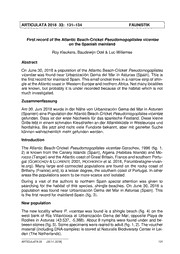
First record of the Atlantic Beach-Cricket (Pseudomogoplistes vicentae) on the Spanish mainland PDF
Preview First record of the Atlantic Beach-Cricket (Pseudomogoplistes vicentae) on the Spanish mainland
ARTICULATA 2018 33: 131–134 FAUNISTIK First record of the Atlantic Beach-Cricket Pseudomogoplistes vicentae on the Spanish mainland Roy Kleukers, Baudewijn Odé & Luc Willemse Abstract On June 30, 2018 a population of the Atlantic Beach-Cricket Pseudomogoplistes vicentae was found near Urbanización Gema del Mar in Asturias (Spain). This is the first record for mainland Spain. This small cricket lives in a narrow strip of shin- gle at the Atlantic coast in Western Europe and northern Africa. Not many localities are known, but probably it is under recorded because of the habitat which is not much investigated. Zusammenfassung Am 30. Juni 2018 wurde in der Nähe von Urbanización Gema del Mar in Asturien (Spanien) eine Population der Atlantic Beach-Cricket Pseudomogoplistes vicentae gefunden. Dass ist der erste Nachweis für das spanische Festland. Diese kleine Grille lebt in einem schmalen Kiesstreifen an der Atlantikküste in Westeuropa und Nordafrika. Bis jetzt sind nicht viele Fundorte bekannt, aber mit gezielter Suche können wahrscheinlich mehr gefunden werden. Introduction The Atlantic Beach-Cricket Pseudomogoplistes vicentae Gorochov, 1996 (fig. 1, 2) is known from the Canary Islands (Spain), Algeria (Habibas Islands) and Mo- rocco (Tanger) and the Atlantic coast of Great Britain, France and southern Portu- gal (GOROCHOV & LLORENTE 2001, HOCHKIRCH et al. 2016, Forumbretagne-vivan- te.org). Many large and connected populations are found on the rocky coast of Brittany (France) and, to a lesser degree, the southern coast of Portugal. In other areas the populations seem to be more scarce and isolated. During a visit of the authors to northern Spain special attention was given to searching for the habitat of this species, shingle beaches. On June 30, 2018 a population was found near Urbanización Gema del Mar in Asturias (Spain). This is the first record for mainland Spain (fig. 3). New population The new locality where P. vicentae was found is a shingle beach (fig. 4) on the west bank of Ría Villaviciosa at Urbanización Gema del Mar, opposite Playa de Rodiles in Asturias (43.537, -5.388). About 8 nymphs were found under and be- tween stones (fig. 5). Some specimens were reared to adult (fig. 1, 2). The voucher material (including DNA-samples) is stored at Naturalis Biodiversity Center in Lei- den (The Netherlands). ARTICULATA 33 [30.11.2018] 131 Fig. 1.: Pseudomogoplistes vicentae, male. Urbanización Gema del Mar. Photo Roy Kleukers. Fig. 2.: Pseudomogoplistes vicentae, female. Urbanización Gema del Mar. Photo Roy Kleukers. 132 [30.11.2018] ARTICULATA 33 Fig. 3.: Fig. 4.: All localities where Pseudomogoplistes Habitat of Pseudomogoplistes vicentae at vicentae is known to occur. The Canary Is- Urbanización Gema del Mar. lands are shown as an inset at the top left Photo Baudewijn Odé. corner. The new site at Urbanización Gema del Mar is indicated with a star. Fig. 5.: Habitat of Pseudomogoplistes vicentae at Urbanización Gema del Mar. Photo Baudewijn Odé. ARTICULATA 33 [30.11.2018] 133 Discussion Pseudomogoplistes vicentae is listed as Vulnerable on the IUCN European Red list (HOCHKIRCH et al. 2016). With this one new record, no change is expected to this assessment. However, this finding proves that directed searches may result in the discovery of more populated habitat in France, Portugal, Spain and northern Africa. Especially climate change could pose a threat to this small cricket which lives in a narrow strip along the sea (SUTTON 2015). An important way of colonising new localities could be through driftwood. When females oviposit in wood this can be picked up during high tide or storms and transported over long distances (pers. comm. Karim Vahed). Acknowledgements We thank Karim Vahed for his comments on the manuscript. Authors: Roy Kleukers EIS Kenniscentrum Insecten / Naturalis Postbus 9517 2300 RA Leiden (The Netherlands) E-Mail: [email protected] Baudewijn Odé De Bongerd 29 6584 DG Molenhoek (The Netherlands) E-Mail: [email protected] Luc Willemse Naturalis Biodiversity Center Postbus 9517 2300 RA Leiden (The Netherlands) E-Mail: [email protected] References GOROCHOV, A.V. & LLORENTE, V. (2001): Estudio taxonómico preliminar de los Grylloidea de España (Insecta, Orthoptera). - Graellsia 57: 95-139. HOCHKIRCH, A., OROMI, P., BRAUD, Y., TIM, G., VAHED, K., FERREIRA, S., PRESA, J.J., ROESTI, C., RUTSCHMANN, F., DUSOULIER, F., ZUNA-KRATKY, T., MONNERAT, C. & FONTANA, P. (2016): Pseudomogoplistes vicentae. - The IUCN Red List of Threatened Species 2016: e.T68460220A74521891. SUTTON, P.G. (2015): A review of the scarce and threatened Orthoptera and allied species of Great Britain. Orthoptera, Dictyoptera, Dermaptera, Phasmida. - Natural England Com- missioned Reports; Species Status No. 21. 134 [30.11.2018] ARTICULATA 33
